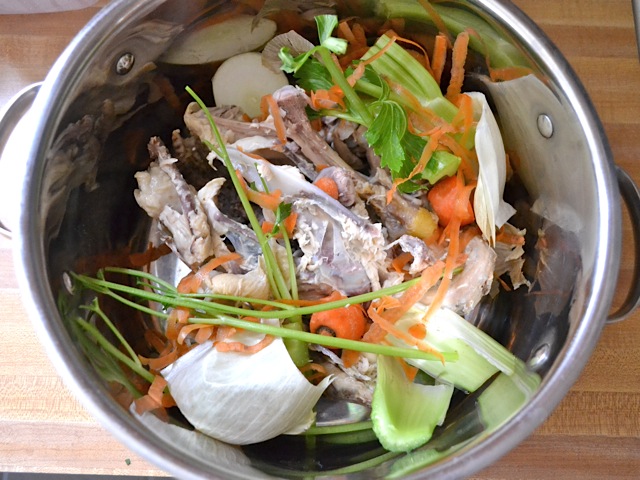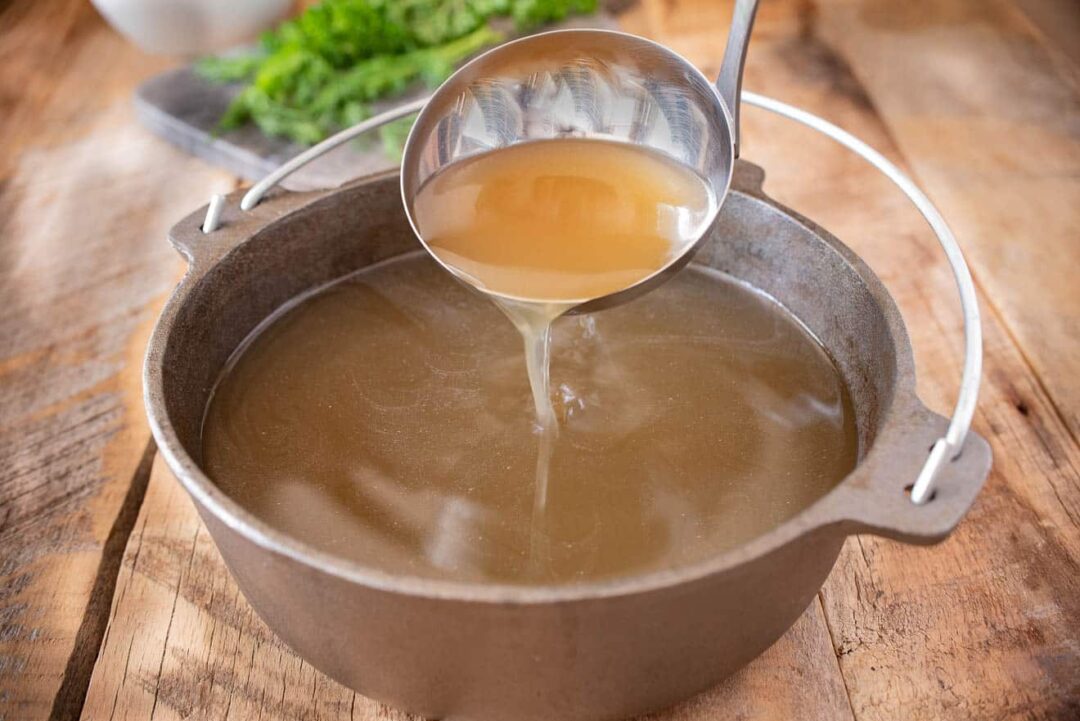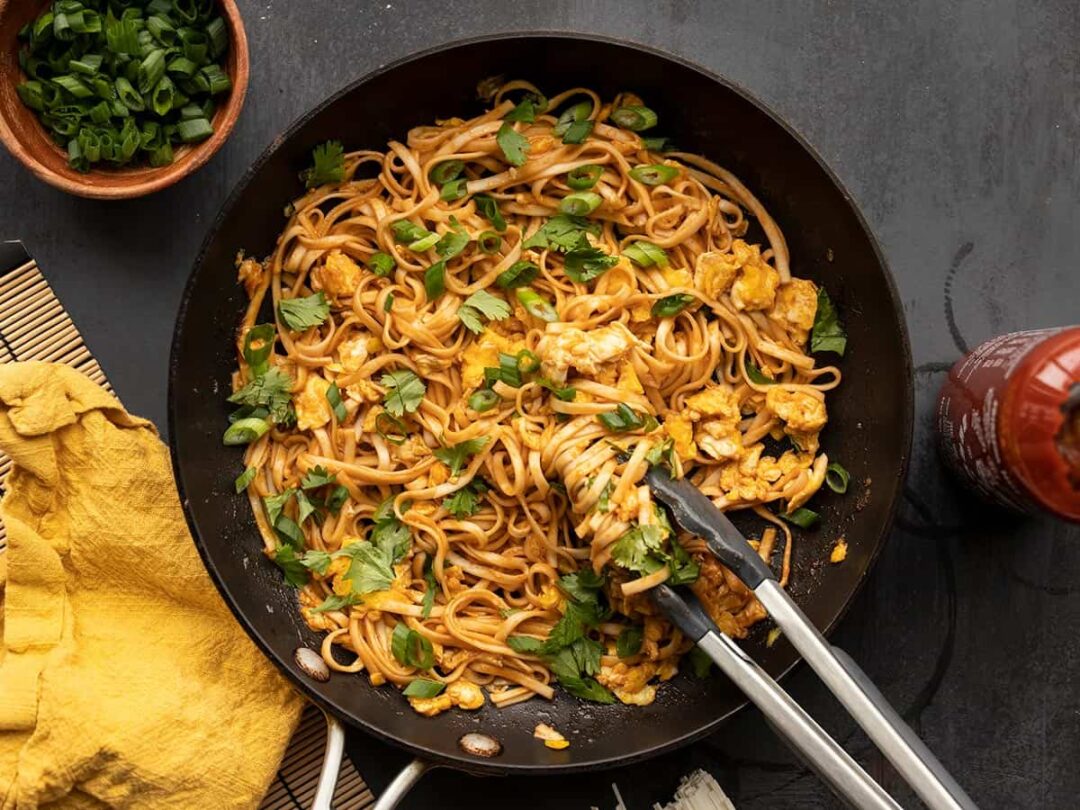First and foremost, let me start this post by admitting that this was my first experience making my own chicken broth from scratch.
I’m almost ashamed to admit that I did not do it for years and it’s almost hypocritical of me not to have ever done it but for some reason I never got around to actually trying it.
It is important to note that this post will not be viewed as a “definitive guide” for making chicken broth, but rather as a “here is my experience, you should also try it!”
I would also appreciate it if you could share your tips and tricks with Apronese.com in the comments, as I know a lot of you have been doing this for a long time, and that we can all learn from each other.
The experience I had was very easy. Seriously, just dump everything into the pot and let it cook.
Then, when you return later, you will have a magical golden liquid full of flavor and nutrients that are good for your health.
The best part of this is that you get to use every last bit of goodness that your chicken and vegetables scraps have to offer by making broth.
This makes me feel warm and fuzzy inside when I know that I am reducing my waste. I look forward to making vegetable broth as well.
Several of my readers have already given me some good tips that I thought I would share:
- If you wish to make broth from your leftover vegetable scraps, just wash them well and store them in the freezer until you are ready to use them.
- Rather than making broth on the stovetop, Theresa suggests making it in a slow cooker instead to save babysitting time. Let it simmer all night and your broth will be perfect in the morning.
I’m excited to hear what everyone else has to say.
A Homemade Chicken Broth Recipe
The best way to make chicken broth
How to make your own homemade chicken broth using scraps from other recipes.
Author: Beth
Prep Time: 10 minutes/ Cook Time: 4hs/ Total Time: 4 hrs 10 mins
Servings: 12 cups
Ingredients
- Vegetable scraps
- Chicken carcass
Instructions
- The chicken carcass should be cleaned off the skin and all the healthy meat removed. Leave the cartilage behind because it will melt into the broth, adding flavor and nutrients. It’s kind of like taking joint supplements, but with a much better taste.
- Rinse your vegetable scraps thoroughly with cool water to ensure they are clean. This recipe can be used for carrots, celery, herbs, onion skins, or any other vegetable scrap you normally throw away. You want to make sure the vegetables will go together, so choose those that “go” together. The vegetables I used were celery, carrots, parsley stems, and onion skins.
- A large pot should be filled with the chicken carcass and vegetable scraps, then covered with enough water to cover them (about 12 cups, depending on how big your chicken was and how many scraps you had). Bring up to a boil over medium-high heat, and then immediately reduce to low and simmer for 3 to 4 hours covered with a lid.
- It is recommended to pipe the broth through a colander after simmering the broth. Remove the colander and throw away any scraps that remain in the colander. Cover the colander with a cheese cloth or some other clean, lint-free cloth, then pour the broth through the colander once more to remove any remaining small particles.
- I divided the broth into smaller containers in order to help facilitate cooling it. I refrigerated the broth until it became cool, then transferred it to the freezer, making sure that each container was labeled and dated as soon as it was frozen.
NOTE: It is quite normal for the fat to rise to the top during cooling in the refrigerator.
You can remove it at this point if desired, but I think that it adds a great deal of flavor to the broth. It is not unusual for your broth to thicken or gel after refrigerating.
That is normal, and it is a good sign that your chicken has been able to provide you with all of its flavor and nutrients.
Step By Step Photos

After roasting a chicken in my slow cooker on the weekend, I removed the meat from the bones and scraps once it had cooled enough to handle. When I was ready to make the broth, I saved the bones and scraps and the bones and scraps from the roasting process.

After collecting a few vegetable scraps, I began making the broth the next day. The first thing you should do is clean up your veggie scraps. Sand in broth is not good. I had celery tops, carrot ends, onion peels, and parsley stems. Put your chicken carcass in a large pot with them.

In a large pot, cover it with fresh water, using 12 cups. Bring it to a boil over medium-high heat, and then reduce the heat to low and let it simmer for 3 to 4 hours (with a lid over the pot).

Put a colander over a large bowl and pour the whole pot through. Discard the scraps collected at the bottom of the pot. Once you have simmered all of the goodness out of your scraps, it’s time to strain out the golden liquid.

Here’s what I had after the first strain. It’s golden and beautiful, and it smells delicious.

For the second strain, just lay the cloth over the colander and refill with water. To remove any particles that may have passed through, you will want to use a fine weave, lint-free cloth.

In all honesty, I don’t know how much it gathered. It didn’t catch much, but I am sure if I had simmered it longer everything would have broken down more and there would be a larger amount of small particles.

I prefer to leave the broth unsalted at this point and add salt later when cooking with it, rather than seasoning it at this point. It’s always a good idea to divide broth (or any food) into smaller containers before refrigerating so it cools down faster. Adding salt at the end of a recipe allows you to use less salt and still get the same flavor punch. Always chill the broth before freezing it.
For liquids and sauces, I like to freeze them in quart sized freezer bags. You can freeze liquids in glass jars, but leave enough room for them to expand as they freeze, otherwise the container will rupture.
That’s all that Apronese wants to bring to you, it’s simple and easy to do, isn’t it? Start doing it today so you don’t have to waste food anymore.







